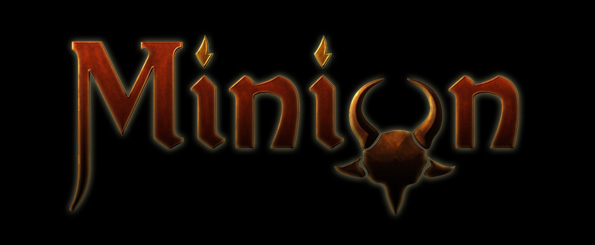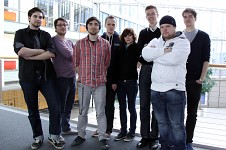
The indie community has been a flourishing breeding place recently for sidescrolling titles, such as the amazing Trine or Limbo. They've shown that even in the days of DX11, it's not just photorealism in games that counts. These titles have been fascinating us as beautiful pieces of art with entertaining game mechanics. So, let me start with the good news: We're doing yet another indie sidescroller - yay! The bad news: it won't be exactly the same that you know from other recent titles.
 Minion is part of a thesis project run at Mediadesign University for Applied Sciences in Düsseldorf, Germany. Voodoo Games is a team of eight game design students who struggle for survival want to go crazy with some fresh ideas before commercial pressure takes over the steering wheel of the creative road train. Some of us have previously been working with Crytek and Ubisoft and we're happy to approach a project on a smaller scope with a smaller, more agile team.
Minion is part of a thesis project run at Mediadesign University for Applied Sciences in Düsseldorf, Germany. Voodoo Games is a team of eight game design students who struggle for survival want to go crazy with some fresh ideas before commercial pressure takes over the steering wheel of the creative road train. Some of us have previously been working with Crytek and Ubisoft and we're happy to approach a project on a smaller scope with a smaller, more agile team.
So what is Minion about?
Well, there's this old, long-serving Knight called Lord Braxia of Brightmore who's got his best years behind him. Bored with his pension, he's longing for another heroic journey to bring him some more fame - not to mention the thrill of an epic adventure. A series of events draws him right into one, but unfortunately you won't be playing him. The player character is actually Minion, a hyperactive demon of lower rank with a tiny inferiority complex. He wants to prove his worth, but due to some circumstances that have just little - very little to do with him, he relies on Lord Braxia to help him out. There's just one problem: who's seriously going to trust any Demon these modern days of an old age?
Playing as Minion, you'll need to find your ways through ancient dungeons and past mean, fluffy or completely meaningless foes, but always out of sight of the Knight who would otherwise immediately kill you. Still, you need to make sure that he reaches the places you want him to go to, through manipulating the environment or guiding foes into the right direction. Different height levels and a limited depth grant you flexibility in movement in order to stay out of sight.
Minion is going to be created as a demo level for our thesis project and if we get some good feedback, might just make it into a commercial project ;)
Choice of technology
During the conception phase of our game, we went through various different options for the engine choice. The democratization of developer tools are truly a blessing for indies, though the choice isn't quite easy. Unity was pretty high on our list due to its flexibility in terms of target platforms, mobile gaming and ease of use for programmers. Unfortunately, like most student teams, we have quite an overhead of artists and designers as opposed to software engineers. Thus, the content and art pipeline simply wasn't sufficient for our purposes. We needed more powerful tools to give our artists more autonomy and reduce the load for our programmer. Otherwise, our technology choice may just have ended up creating a single point of failure by overloading one critical resource.Next up, we took a look at the CryEngine 3 SDK. It's interesting in many ways: the toolset is a lot broader and especially the WYSIWYP (what you see is what you play) approach to the dev tools is very interesting for iterative level design and AI pathing, which are critical elements to our game. CryEngine 3 is pretty much the only broad SDK that stripped down any artifacts from the good old days of BSP engines. All the lights are dynamic, scripts can be altered at runtime and there is no need to compile anything other than the C++ code. While this seemed to be a perfect solution for our level designers and artists, the engine fell short in terms of code documentation, thus being an overcomplicated solution for entrance-level coders. Another reason against CryEngine 3 SDK was the quite annoying login system. Crytek introduced a project management system that would encrypt all map files, offering decryption based on a team system with individual developer accounts. While this is a handy solution to prevent critical leaks during development, its mandatory implementation - even in the launcher - can turn out quite annoying, resulting in freezes and crashes due to our protected university network.
Our final choice turned out to be the UDK. Despite the fact that it does require compiling levels to a certain extent, its art and content pipeline met our needs in a similar fashion as the CE3 SDK while providing an easier approach to the game code. On the bright side, this also allows us to target the Mac platform as well as iOS, which grants us some additional distribution options down the line.
During the course of development, we will be documenting our progress, design decisions and experiences. We hope this will be interesting for other developers as well and are looking forward to discuss with you :)




Quote: "The bad news: it won't be exactly the same that you know from other recent titles."
How is this bad news? ;) I think you guys are better off with something creative and different. Overall it sounds like an interesting idea and since my team is also using UDK, I will be tracking your progress. Can't wait to see some gameplay!
Greetings from Hamburg.
Ignite the World!
Lyrahel
Oh that was pure </irony> ;)